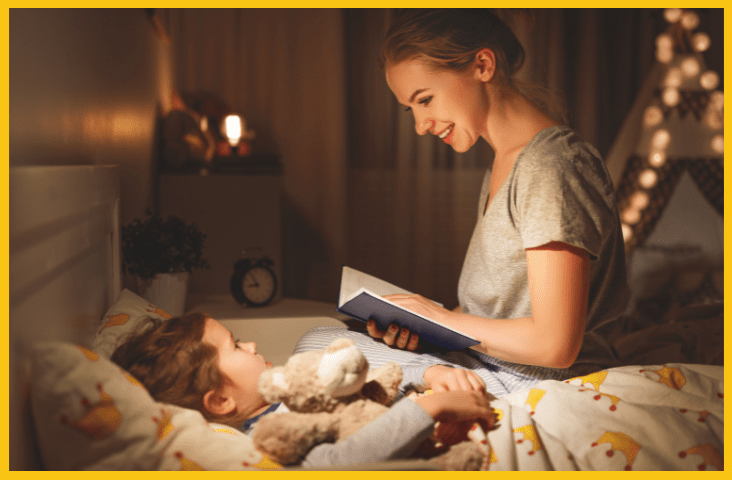
How to create a calming, connected bedtime routine for your child
Bedtime is a struggle for many of the families I speak to in my practice. By the time bedtime rolls around, parents are often exhausted, touched out, and desperate for some alone time. They’ve been on the go all day long, working, wrangling small children with big feelings, completing errands or doing housework. And they’re running on empty by the end of the day. They often feel like they have nothing left to give. They want their child to get into bed without complaint. And then stay there – so they can finally sit down and b-r-e-a-t-h-e.
Add to this, children who insist they can’t sleep, heard a noise outside, need a 3rd cup of water, a 7th bedtime story, 52 trips to the toilet, and then mum – no, dad – to tickle their back and sing them a song while they drift off – and bedtime can really be a struggle.
However, bedtime is a super important part of your child’s day, and a wonderful opportunity to provide your child with the safety, security, and connection they need. So let’s talk about how you can make this time more peaceful, calming and connecting for you and your child. But first, why is this time so important?

Why is bedtime important?
Aside from the obvious fact that kids NEED restful, restorative, healthy sleep for optimal growth and development, bedtime is also the most significant transition of your child’s day. After all, depending on their age, once they go to sleep, they will be away from you for at least 8 hours – sometimes up to 12!
And for very young children especially, this extended separation from you can be scary. Add in things like fears of monsters, the dark, and things that go bump in the night, and it is understandable that children might find this transition difficult.
Children need lots of positive experiences with this transition before they can do it well. They need to know that they are safe, and loved even when you are not physically present. Being away from a caregiver is a very real, very valid fear for children. So we need to ensure we provide lots of opportunities for children to feel safe at bedtime – we need to give them plenty of safety cues. That’s where bedtime routines and rituals come in handy.

Why are bedtime routines important?
Bedtime routines, and the rituals embedded within them – help to make bedtime predictable, safe, and positive for children. When children know exactly what to expect at bedtime, they feel safer. They feel calmer. And they resist the transition less.
Our job as parents is to help our children feel so secure, loved and connected to us at bedtime, that the inevitable separation feels less scary. We need to fill their love tank to overflowing so they have plenty to sustain them during the night.
Here are 5 ways you can start to do that, right now.
5 ways to help make bedtime more peaceful
1. Take a pause yourself
The first thing to do is to take a look at how YOU are approaching bedtime. If you are rushed, feeling frustrated, and just trying to get it over and done with so you can have some time for yourself, then bedtime will be anything but smooth. And yes, I know you are exhausted. I know you just want to relax and switch off for the evening.
But if you are able to approach bedtime with intention. to see it as an opportunity to slow down, connect with your child and truly be present – it will be so much smoother for everyone!
So before you begin the bedtime routine each evening, try taking a pause yourself. An intentional gear shift so you can be fully present for your child.
I like to use the STOP acronym for this.
S – STOP what you are doing and take a moment to honour the beginning of this transition
T– TAKE a breath (or 2 or 3) and calm your nervous system.
O – OBSERVE what’s happening for you. What are you thinking? What physical sensations do you notice in your body? How do you feel? Just take a moment to acknowledge that.
P – PROCEED with intention. How do you want to approach this time with your child?

2. Create a calming atmosphere
Environmental cues are hugely important within the bedtime routine. Preparing the physical environment for sleep helps your child’s brain predict what is coming and begin to wind down for sleep. And doing the exact same thing each night creates a sense of predictability that helps your child feel safe, too.
Think about the ways you can prepare your home for bedtime and support your child to wind down. I like to consider all of the senses when I do this:
Sight: Draw the blinds, turn out the lights, turn on a nightlight or lamp
Sound: Reduce the background noise in the house, turn on soft music, a relaxation or mindfulness track, sing a comforting lullaby or song to your child, speak in soft voices
Smell: Light a scented candle, turn on the diffuser, use a scented bubble bath or body wash, or a scented lotion
Touch: Lots of cuddles, an after bath massage or foot rub, back tickles, a favourite soft teddy or comforter to snuggle, or a cozy blanket on the bed and a super tight tuck in!
Taste: A drink of warm milk, a cool glass of water, or brushing teeth with minty toothpaste
3. Use visual reminders
Help children feel safe and secure by using visual reminders that help them know exactly what is coming next in their routine. This might be a visual routine chart with pictures for younger children. It may also be a clock or a timer that helps them know when it’s time to move to the next activity or step in their routine.
Visual reminders also take some of the pressure off you as the parent. Instead of feeling like you are nagging, repeating yourself, or not being heard, you can simply direct your child to the routine chart when you notice that things have stalled.

4. Give children some control
Routine charts also help children feel a sense of control, as they are in charge of navigating the chart and moving through the steps of the routine. Helping children feel a sense of control or autonomy at bedtime will help them feel much more safe and secure and make the transition to sleep easier for them too.
Autonomy is a very real and valid need for all of us – children and adults alike. No human being likes to feel that they have no control in a situation. And force creates resistance. So if bedtime becomes a battle of the wills or descends into a power struggle, the situation will only escalate. Instead, try to find things you can let go of. Opportunities for your child to have a voice and a choice.
Age-appropriate choices for small children might include:
- Which pyjamas they wear
- Which books you read
- Which bedtime song you sing
- Which teddy they want to sleep with
- Whether mum or dad puts them to bed tonight
- Which playlist or meditation you listen to
5. Establish rituals that help you connect with each other
The best way to ease any transition is to ensure they include lots of opportunities for connection. Connection helps kids feel safe and secure and bedtime rituals that include points of connection will make it easier for your child to make the transition from awake to asleep, and from with you to away from you.
We want to leave kids feeling so loved and so treasured and so safe and secure at night that fear disappears and sleep comes easily. Which means, especially for younger children, a simple hug and kiss and then leaving them in their room alone, may not be sufficient.

Instead, we can incorporate rituals into the nightly routine that helps you feel connected to your child. Some ideas might include:
- Reading stories together
- Listening to an audiobook
- Snuggling in bed and talking about your day
- Listing 5 things you are each grateful for
- Listing 3 things you love about each other
- A gentle massage or back rub
- A special goodnight ritual/kiss/hug
- Have a dance party before getting into bed
- Playing a board game or card game before bathtime
- Having a shower or bath together with your younger child
- Playing a silly game that gets the giggles out
Ultimately, the biggest barrier to bedtime is often our own beliefs and expectations. If we can remember that children are not intentionally trying to manipulate us at bedtime, or make our lives harder, but that they have a genuine need for connection and safety at this time, we will find it so much easier to navigate. Think of it like this: your beautiful child loves you so much and feels so safe in your presence that they want you close by at all times. What an honour and a privilege that is as a parent.
Sarah Conway is a child and adolescent psychologist, mother of 4, and founder of Mindful Little Minds. She has over 15 years of experience working in mental health with children, teenagers, and families. Sarah’s mission is to help parents move away from punitive parenting strategies and towards mindful, intentional parenting that builds emotional intelligence in kids and parents alike. As a busy mum herself, she knows firsthand how difficult mindful parenting can be, particularly when it was never modeled by our own parents. That’s why she provides parents and children with simple, practical strategies and tools that help them learn to manage emotions – together. She believes that changing the way we parent will change the world.


